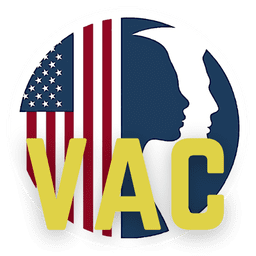VAC Services
Veterans Treatment Court
Mandated by state law for all Illinois judicial circuits, the program is designed to give veterans incentives and opportunities to avoid jail and prison time in exchange for a strict two-year probation program that keeps them on track to complete goals such as substance abuse and mental health counseling and treatment.

What is the Veterans Treatment Court?
A large proportion of military veterans may experience substance use disorders, mental health issues, such as posttraumatic stress disorder or traumatic brain injury, difficulties readjusting to life at home, homelessness, and criminal justice system involvement.[1] Veteran’s courts tend to be hybrids of drug court and mental health court, as they are often dealing with participants suffering from both mental health substance abuse issues.[2] The number of veteran’s courts increased 14-fold from 2009 to 2014.[3]
One component unique to veteran’s courts is the use of mentors who have been in combat and understand the frame of mind after such an experience. Mentors have been found to help veteran participants overcome their issues.[4] Other key components, which are similar those found in other PSCs include:
- Integration of alcohol, drug treatment, and mental health services with justice system case processing.
- Using a non-adversarial approach when prosecution and defense counsel promote public safety while protecting due process rights of participants.
- Early identification of eligible participants who are promptly placed in Veterans Treatment Court program.
- Access to a continuum of alcohol, drug, mental health and other related treatment and rehabilitation services.
- Abstinence monitored by frequent alcohol and drug testing.
- Coordinated strategy governs response to participant’s compliance.
- Essential ongoing judicial interaction with each individual.
- Monitoring and evaluation measure achievement of program goals and gauge effectiveness.
- Continuing interdisciplinary education to promote effective court planning, implementation and operation.
- Forging partnerships among treatment court, Veterans Administration, public agencies and community-based organizations generates local support and enhances court effectiveness.
Although veteran’s courts have not been as rigorously evaluated as other types of PSCs, evaluations have been positive. One study found that veteran court participants experienced significant improvement in symptoms of PTSD and depression, substance abuse, overall functioning, emotional health, relationships with others, recovery status, social connectedness, family functioning, and sleep.[5] Another study following participants six and 12 months after veteran’s court completion found 90 percent of participants were arrest-free during participation and after participation experienced significant improvements in symptoms of depression and PTSD and substance use.[6] Researchers also have found recidivism rates of participants are lower than overall state recidivism rates.[7] Further evaluation is needed using more rigorous research designs.
[1.] Baldwin, J.M. (2013). Veterans’ treatment courts. Trends in state courts. Williamsburg, VA.: National Center for State Courts. Retrieved from http://www.ncsc.org/sitecore/content/microsites/future-trends-2013/home/; Russell, Robert. T. (2009). Veterans treatment court: A proactive approach. New England Journal of Criminal and Civil Confinement, 35(1), 357. Retrieved from http://www.american.edu/spa/jpo/initiatives/drug-court/upload/Veterans-Treatment-Court-A-Proactive-Approach.pdf. ↩︎
[2.] National Institute of Corrections. (2016). Veterans treatment courts: A second chance for vets who have lost their way. Washington DC: Department of Justice.; The U.S. Department of Veterans Affairs, National Center for PTSD (2015). Keeping veterans with PTSD out of the justice system. Washington DC: Author Retrieved from http://www.ptsd.va.gov/public/community/keeping-PTSD-vets-out-JS.asp. ↩︎
[3.] Marlowe, D. B., Hardin, C. D., & Fox, C. L. (2016). Painting the current picture: A national report on drug courts and other problem-solving courts in the United States. National Drug Court Institute, National Association of Drug Court Professionals.; Hawkins, M. (2010). Coming home: Accommodating the special needs of military veterans to the criminal justice system. Ohio State Journal of Criminal Law, 7, 563-573. Retrieved from http://moritzlaw.osu.edu/osjcl/Articles/Volume7_2/Hawkins-FinalPDF.pdf. ↩︎
[4.] Moore, E. C. (2012). A mentor in combat veterans court: Observations and challenges. Future Trends in State Courts 2012. National Center for State Courts. Williamsburg, VA. Retrieved from http://ncsc.contentdm.oclc.org/cdm/ref/collection/spcts/id/233.; Knudsen, K.J. & Wingenfeld, S. (2016). A specialized treatment court for veterans with trauma exposure: Implications for the field. Community mental health, 52(2). 127-135 ↩︎
[5.] Knudsen, K. J., & Wingenfeld, S. (2016). A specialized treatment court for veterans with trauma exposure: Implications for the field. Community Mental Health Journal, 52(2). 127-135. ↩︎
[6.] Knudsen, K. J., & Wingenfeld, S. (2016). A specialized treatment court for veterans with trauma exposure: Implications for the field. Community Mental Health, 52(2). 127-135. ↩︎
[7.] Steele, J. (2015, January 11). Veterans court looks to expand. The San Diego Union-Tribune. Retrieved from http://www.sandiegouniontribune.com/military/sdut-veterans-treatment-court-sandiego-permanent-2015jan11-htmlstory.html. ↩︎

